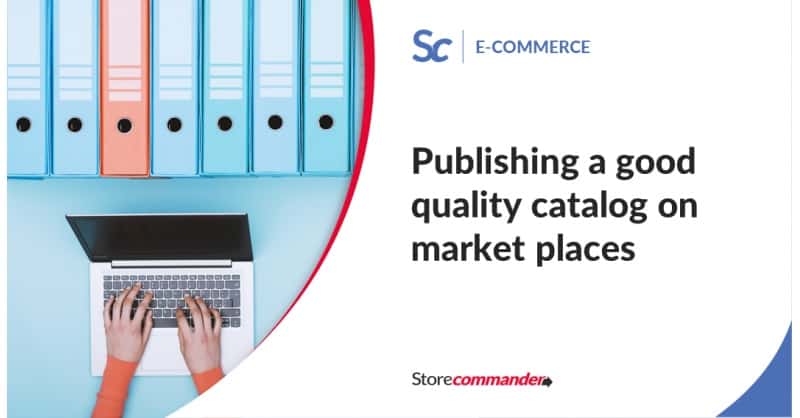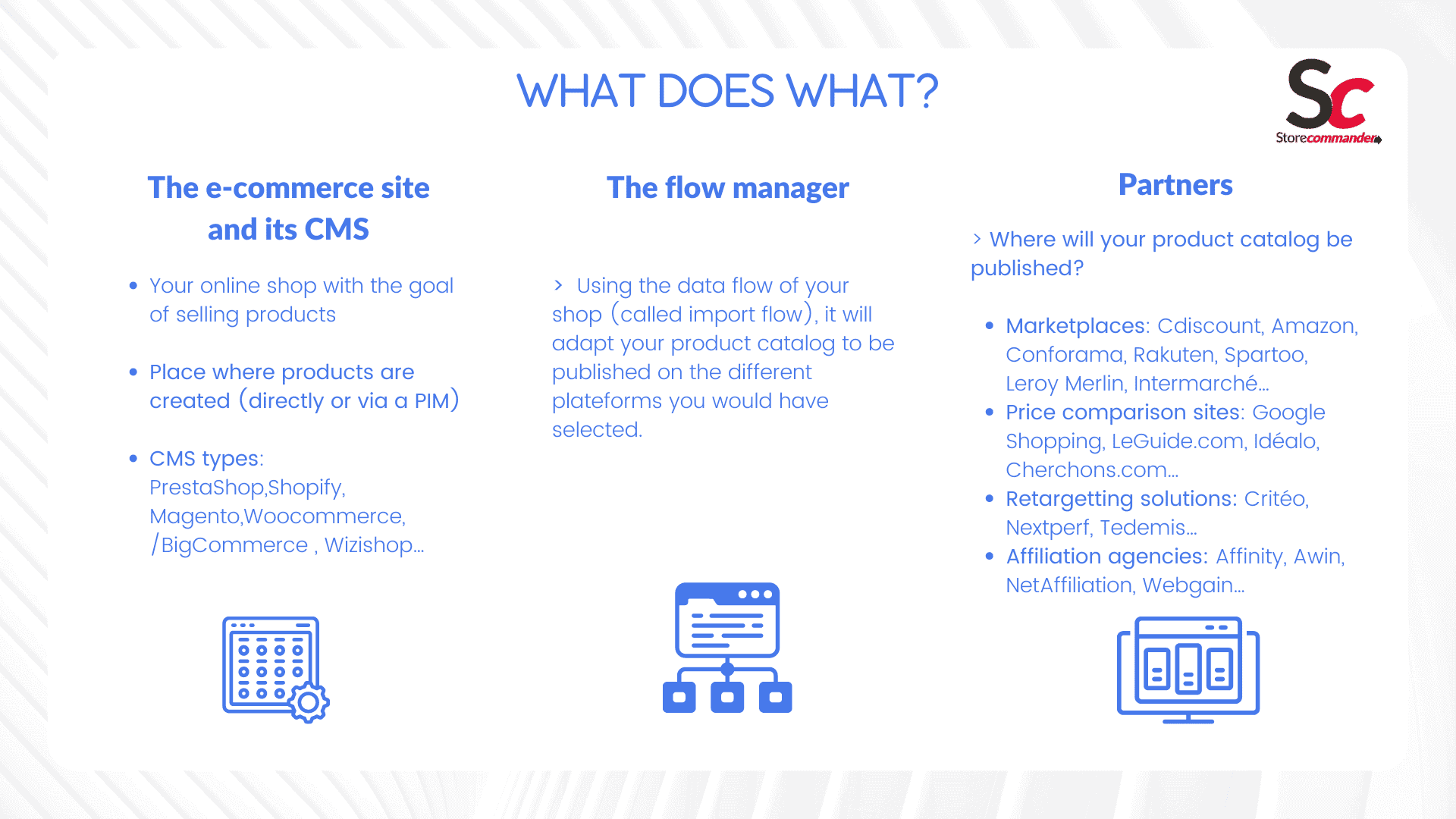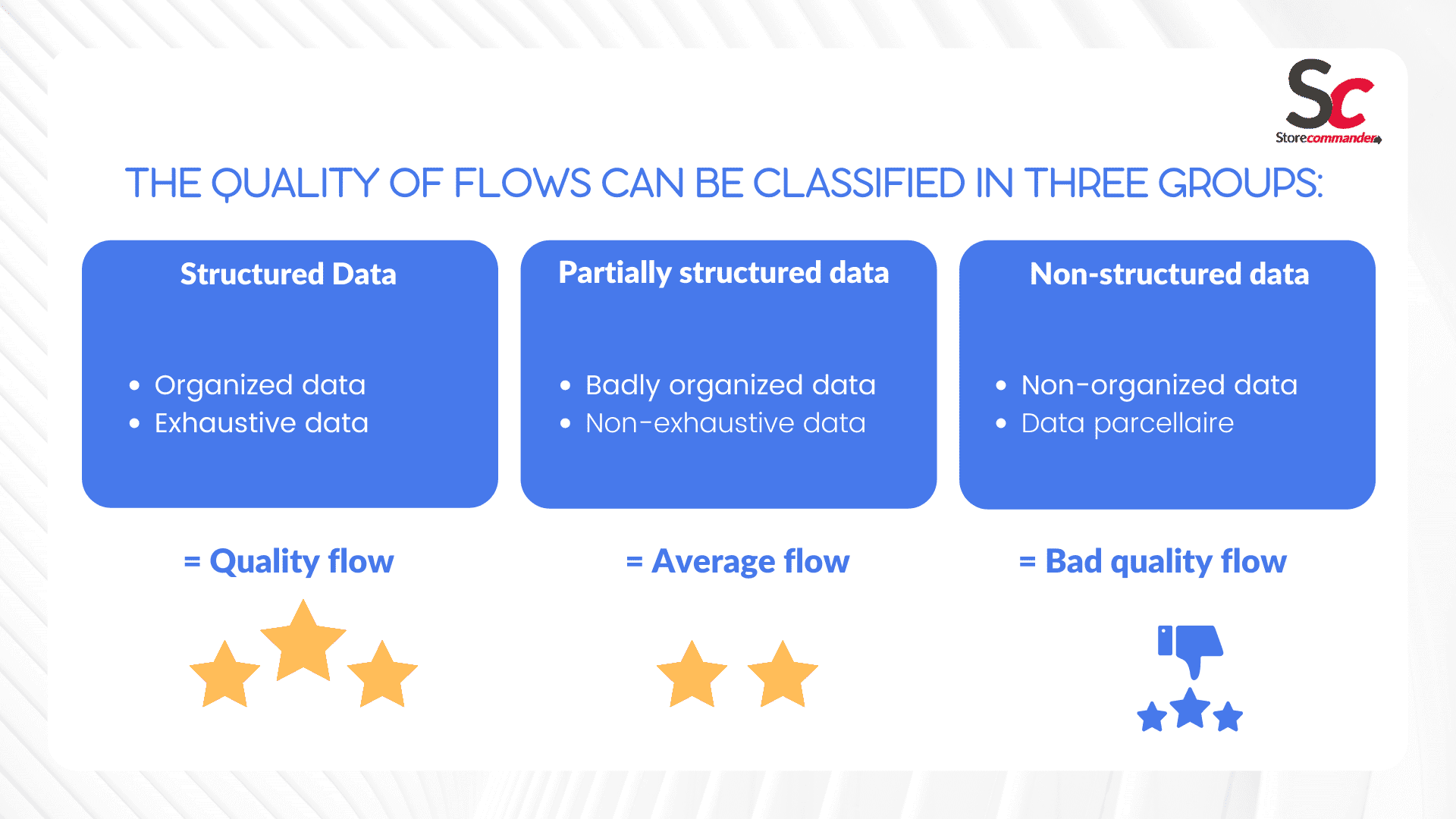Publishing a good quality catalog on market places

Make the most of your workflow manager with Store Commander.
When building your own house, improving or extending it, the most important part is the fundations. We should be able to rely on strong bases, both literally and figuratively. This 'flow' corresponds to your e-commerce data, and it's simple: it's just the same!
Upstream from the flow management, as an e-merchant, it'll be necessary to structure and organize the data in the backoffice of your site. And this is where Store Commander comes on the scene.
We're going to present you a quick overview to remind you of a few principles you should be aware of in order to implement good practices, the points of vigilance to be taken into account and the thoughts to be had.
Prerequistes: what does what?

In theory, everything is simple, but the reality is a little more complex. Let's see together a few definitions to clarify the process.
1. What's a flow?
The flow is the file containing the data that will create your product sheets and that will publish your offers when we refer to market places.
On the other hand, this file is not only used to create products, it will also add value to the platform concerned by completing their matrices, which can be very restrictive.
Some fields are compulsory, other optional, but as always the devil is in the details! The more you are able to comply with partners' needs, the better the exposure of your offers will be. For example, if you sell a product that meets a safety standard, even though this field is not mandatory, it is likely that this criterion will be a determining factor in your potential customer's choice to buy. In which case, he could make it a key criterion of his search, and therefore filter the offers by this criterion. If the criterion in question is not important, its negative impact will be weak, but the opposite is not true, on the contrary...
In short, these fields are crucial, especially since if you do not complete them, your competitors will certainly do so and you will therefore have a competitive disadvantage, not on price but on product information. So much effort to fail on a missing field, what a shame!
It is not enough to fill in the requested information, it must be done in a way that is adapted to make it usable by the platform, meaning in a structured way.
The quality of flows can be classified in three groups:

An e-shop has to be in one of these three groups.
- In the 1st case, victory!!! The data is usable as is. We must maintain the quality of the data and continue to enrich it.
- In the 2nd case, the quality of the data is sufficient enough to be used. The basics are good, but the structure of the data must be improved, organized and enriched. At this stage, improvement work is to be recommended before any publication via a flow manager to avoid difficulties.
- In the 3rd case, it is very likely that the integration of the export flow will be of poor quality. Launching as is will be a big risk and certainly a mistake. It is strongly recommended to work on the data to improve the import flow. An important global work is necessary.
2. What's a good import flow?
Simple question, but more nuanced answer: it depends!
What does it depend on? On its objectives...
Don't worry, there are still principles to respect and we go back to the house and its foundations. This import flow is the mirror of your online store in the form of data. If your data is good in your online store, then it will be good in your import flow.
If the data isn't good, then you'll try to fix it within the flow manager interface. But that's not what it's designed for: you're asking the tool to do a task it's not been developped for.
The right solution: strengthen the fundations of your house (going back to our metaphore). Especially, in this specific case, fixing issue at the source, meaning where it should be done to then be taken into account automatically and to assure a maximal deployment: your online store.
3. What's a good data?
It is a data that will reconcile the issues of your online store and allow their optimal use in the flow manager.
In fact, you must define the content that your site must have to meet the expectations of your customers, taking into account the specificities of your product universe. The objective will be to obtain a product sheet with all the relevant information.
You will have to work on your data in such a way as to make the most of the different types of criteria that may exist:
- Organizing your categories
- Creating product features (for example a piece of furniture made out of beechwood, a safety standard, a type of fabric...)
- Creating product attributs to offer combinations (size, color..)
- Associating products
- Managing tags
- Etc
This information will facilitate navigation and search on your site. It will then be included in the fields flow, which will be very useful for the flow manager to adapt your export flow to the facets required by the marketplaces. It is the size of your catalog, but also the specificities of the products you sell that will guide you on the relevant and differentiating choices to make.
Finally, this data will need to be structured in order to be used on your site or on the marketplaces via the flow manager.
Let's forget about metaphores, what's the practice?
This work of structuring data is certainly tedious, but indispensable. That's why you need good tools to manipulate your data in the most efficient way possible.
This is precisely what Store Commander for PrestaShop has been doing for over 10 years, and more recently for Shopify.
Our solution allows you to operate your PrestaShop backoffice in a fast and agile way. You will be able to:
- Create and modify your product catalog in bulk (import tool)
- Work on your categories (create/modify)
- Create features and/or attributes
- Structure your data
- Complete fields to optimize the SEO information
- Etc
In a fine way, you will be able to enrich your product sheets and make them fully exploitable via your import flow in the flow manager.
Store Commander brings together the right tools to make your data structuring work efficiently by also allowing you, for the PrestaShop CMS, to :
- Process your photos: automatic and/or manual cropping, resizing, reorientation, creation of shaded effects for your visuals and then compression for optimum web use
- Manage your prices: mass modification, programming, verification and control of margins
- Detect errors: a tool in the form of a control tower for your data that will be very useful for identifying and correcting errors that are prohibited for marketplaces, such as duplicate EAN / SKU codes, products without images, categories without products, uncategorized products,
- Etc.
On Shopify, Store Commander will allow you to massively modify your catalog, agilely exploit your tags, metafields, etc.
The key to success
Through this article, we have seen how essential data quality is. So, in order to develop your sales on marketplaces, you need product flows that are adapted to the specificities of the various existing players.
Feed managers offer tools for parameterization and configuration. However, to take full advantage of the power they can offer you, you need a quality source feed, imported from your online store, with as much information as possible, well organized and correctly structured. This work on your data is done in your online store.
The Store Commander tool allows you to work on your data in your back office quickly and efficiently. Thanks to a quality, robust and durable distribution of your data, you will develop your activities with complete peace of mind and your business will be boosted!